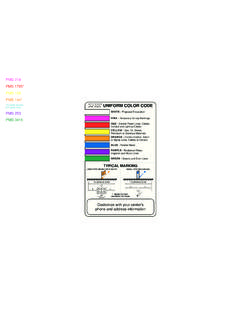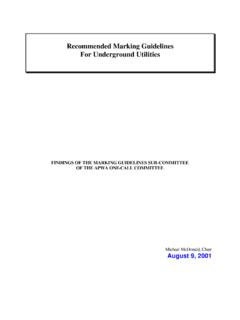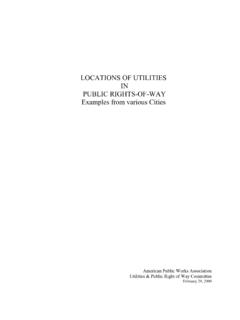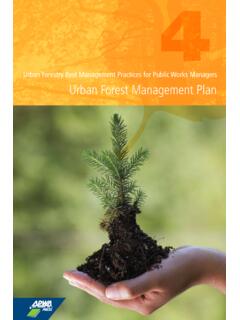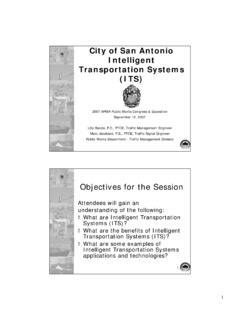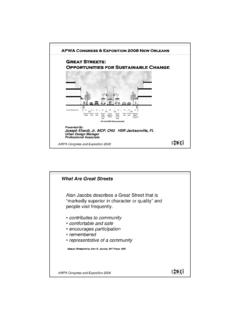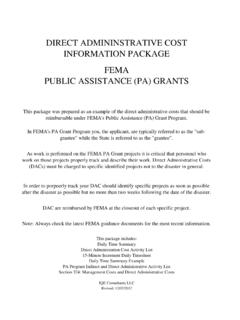Transcription of Literature Review - American Public Works Association
1 Urban Forest Management and Public Works : Improving Communication and Building Capacity February, 2007 Literature Review and Summary Report Literature Review and Summary Report Urban Forest Management and Public Works : Improving Communication and Building Capacity February, 2007 Prepared for The American Public Works Association 2345 Grand Boulevard, Suite 500 Kansas City, Missouri 64108-2641 Prepared by Davey Resource Group 1500 North Mantua Street Box 5193 Kent, Ohio 44240 800-828-8312 Davey Resource Group iTable of Contents Sources Reviewed ..1 Findings ..2 Discussion ..3 Staffing ..3 Regulations and Policies.
2 3 Urban Forest Public Books and Other Publications/Surveys ..14 Appendice A. Literature Review Summary Davey Resource Group 1 Background A comprehensive Literature Review was performed in support of the American Public Works Association s project, Urban Forest Management and Public Works : Improving Communication and Building Capacity. The purpose of the Literature Review was to determine the type, extent, and content of research and information that is readily available regarding urban forest management in the municipal Public Works context. The findings of the Literature Review are a resource for the project steering committee to use to determine the key components of a successful urban forestry program.
3 The findings of the Literature Review also identify where there is a lack of accessible and relevant information on the subject. Sources Reviewed A variety of Literature sources were researched and reviewed; those included professional journals, professional trade magazines, popular publications, on-line publications, and organizational websites. Over 20 sources were reviewed. The specific sources of Literature and information and the number of documents found related to the project s topic of urban management within a Public Works context are presented in Table 1. Source Number of Related Documents Found Journal of Arboriculture 24 Municipal Index 6 American City and County 5 Journal of Forestry 4 City Trees 4 Public Works Management and Policy 4 American Public Works Reporter 3 Journal of the American Planning Association 3 American Forests 2 Results of a Survey of Society of Municipal Arborists Members/Prospective Members 2 Public Works Magazine 1 American Review of Public Administration 1 Municipal Tree Management in the United States 1 Urban Forests Landscapes: Integrating Multidisciplinary Perspectives 1 Urban Forestry.
4 Planning and Managing Urban Greenspaces 1 Urban Forest: Comprehensive Management 1 Grounds Maintenance 0 International City/County Management Association 0 Urban Forestry South Expo 0 Northeast Center for Urban and Community Forestry 0 New York State Urban and Community Forestry Council 0 Davey Resource Group 2 The above list of sources is not presented to be a conclusive and exhaustive list of all topical urban forestry or Public Works related Literature and information. The Literature sources reviewed were identified through suggestions made by Steering Committee members, from known bibliographies, from internet-based research, and from professional knowledge.
5 The objective of this task was to research a broad-based range of existing and easily accessible sources of information to gauge the level of availability of urban forestry information to Public Works staff. A complete listing of authors, titles, and abstracts accompany this report and is organized by primary source in Appendix A. Findings The Literature Review revealed that no single source of information or document precisely contained information on successful urban forest management in a Public Works context. However, the Literature and sources of information reviewed did cover a broad range of urban forest management and related topics.
6 The most prevalent themes are summarized below in order of frequency: Case studies of urban forestry programs in various American cities and states Federal urban forestry programs, initiatives, and guidelines Technological advances and tools for urban forest management and analysis Urban forest benefits and measurements Urban planning Urban forestry management statistics An analysis of the Literature and information sources reveals that there are a variety of urban forest management program components and issues commonly cited as important to building, sustaining, and growing a program regardless of the organizational structure and location of the forestry program.
7 These components and/or issues are presented below in topical groups: Staffing Regulations and Policies Urban Forest Benefits Public Outreach/ education Technology Davey Resource Group 3 Discussion The Literature reviewed discussed or presented facts and opinions on five major topical components of a comprehensive urban forestry program. The following discussion provides a brief synopsis of the major points or elements presented for each topic. Staffing A truly proactive and comprehensive urban forest management program requires trained and dedicated staff to oversee management and operational activities.
8 The important duties of tree planting, tree maintenance, emergency response, plan Review , development site inspection, project management, contract administration, interagency assistance and coordination, and citizen education , among others, require a sufficient level of staffing with appropriate training. Staff responsible for urban forest management should also be professionally certified or have access to certified employees to assist in making operational and management decisions. The level of staffing and types of positions will vary with the size of the city, the Public tree population, and the degree of responsibility as defined by local regulations.
9 No guidelines were given as to the appropriate personnel complement for an urban forestry program; however, it was agreed that at least one management level position should exist that is dedicated solely to urban forestry operations and management. This person should also have access to sufficient in-house or contractual resources to manage a proactive program. Regulations and Policies Research and professional opinions in the Literature strongly suggest that tree ordinances and clear urban forest management policies are the foundation of a sustainable program. Such regulations and guiding principles establish the authority and accountability for tree management, set minimum standards for maintenance and planting, and can help protect and preserve the existing urban forest canopy.
10 Examples of these types of regulations and policies are: tree ordinances, tree preservation ordinances, site development regulations, landscape guidelines; urban forest management plans, emergency response plans, and planting plans. Urban Forest Benefits Compelling statistics and findings from a great number of peer-reviewed, scientifically valid, and legally defensible studies are currently available to describe the enormous impact vigorous, well-maintained Public trees and forests have on our cities. These benefits can now be quantified in terms of a variety of green infrastructure services stormwater management, air pollution control, water quality improvement, carbon sequestration, energy consumption reductions, among others.
